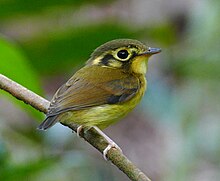White-throated spadebill
| White-throated spadebill | |
|---|---|

| |
| Scientific classification | |
| Domain: | Eukaryota |
| Kingdom: | Animalia |
| Phylum: | Chordata |
| Class: | Aves |
| Order: | Passeriformes |
| Family: | Tyrannidae |
| Genus: | Platyrinchus |
| Species: | P. mystaceus
|
| Binomial name | |
| Platyrinchus mystaceus Vieillot, 1818
| |

| |
| Synonyms | |
| |
The white-throated spadebill (Platyrinchus mystaceus) is a tiny
Description

The adult white-throated spadebill is 3.8 inches (9.7 cm) long, weighs 0.33 oz (9.4 g), and has large eyes and a very short tail. The large head is distinctively marked, with a long yellowish supercilium, blackish ear coverts, yellow eyering, and a black stripe down each side of the neck. The crown has a concealed yellow crest, which is erected as a fan by the singing male. The upperparts are dark olive brown, and the underparts are buff apart from the white throat. The bill is black above and brown below, and is very broad and flat, hence the English and scientific names "spadebill" and Platyrinchus.
Sexes are similar, other than the female having a smaller crown patch, but young birds are brighter and ruddier above, lack the crown patch, and have a grey throat and breast shading to a whitish belly. They are not particularly vocal but have a sharp chweet call.
The subspecies Platyrinchus mystaceus insularis occurs only in Trinidad, Tobago and in Venezuela, other forms differing in the brightness of the underparts or the crown colour. The taxonomy of this species is uncertain, with some dubious subspecies, but also the possibility that what is usually treated as the white-throated spadebill consists of more than one species.
Distribution and ecology
The white-throated spadebill breeds from
This species is found in wet hill forests and will to some extent use
White-throated spadebills are solitary active birds, difficult to see as they move rapidly through the undergrowth in search of small
The deep cup nest is made of dead grass and plant fibres and placed low in a sapling. The typical clutch is two yellow-tinged white eggs with a rufous wreath.
Notes
References
- de A. Gabriel, Vagner & Pizo, Marco A. (2005): Foraging behavior of tyrant flycatchers (Aves, Tyrannidae) in Brazil. Revista Brasileira de Zoologia 22(4): 1072–1077 [English with Portuguese abstract].
- ffrench, Richard; O'Neill, John Patton & Eckelberry, Don R. (1991): A guide to the birds of Trinidad and Tobago (2nd edition). Comstock Publishing, Ithaca, N.Y.. ISBN 0-8014-9792-2
- Hilty, Steven L. (2003): Birds of Venezuela. ISBN 0-7136-6418-5
- Machado, C.G. (1999): A composição dos bandos mistos de aves na Mata Atlântica da Serra de Paranapiacaba, no sudeste brasileiro [Mixed flocks of birds in Atlantic Rain Forest in Serra de Paranapiacaba, southeastern Brazil]. Revista Brasileira de Biologia 59(1): 75-85 [Portuguese with English abstract].
- Stiles, F. Gary & Skutch, Alexander Frank (1989): A guide to the birds of Costa Rica. Comistock, Ithaca. ISBN 0-8014-9600-4
- Salaman, Paul G.W.; Stiles, F. Gary; Bohórquez, Clara Isabel; Álvarez-R., Mauricio; Umaña, Ana María; Donegan, Thomas M. & Cuervo, Andrés M. (2002): New and noteworthy bird records from the east slope of the Andes of Colombia. Caldasia 24(1): 157-189 [English with Spanish abstract]. PDF fulltext

